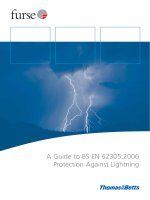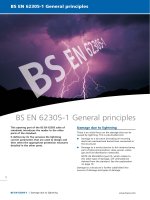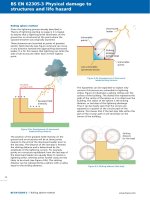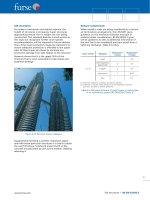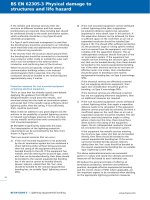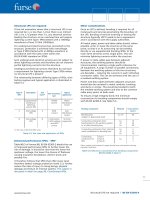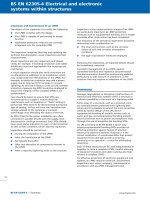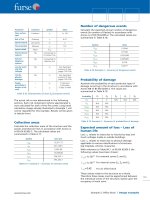Bsi bs en 00725 1 1997
Bạn đang xem bản rút gọn của tài liệu. Xem và tải ngay bản đầy đủ của tài liệu tại đây (120.61 KB, 12 trang )
BRITISH STANDARD
Advanced technical
ceramics Ð
Methods of test for ceramic
powders
Part 1. Determination of impurities in
alumina
The European Standard EN 725-1 : 1997 has the status of a
British Standard
ICS 81.060.99
NO COPYING WITHOUT BSI PERMISSION EXCEPT AS PERMITTED BY COPYRIGHT LAW
|
|
|
|
|
|
|
|
|
|
|
|
|
|
|
|
|
|
|
|
|
|
|
|
|
|
|
|
|
|
|
|
|
|
|
|
|
|
|
|
|
|
|
|
|
|
|
|
|
|
|
|
|
|
|
|
|
|
|
|
|
|
|
|
|
|
|
|
|
|
|
|
|
|
|
|
|
|
|
|
|
|
|
|
|
|
|
|
|
|
|
|
|
|
|
|
|
|
|
|
|
|
|
|
|
|
|
|
|
|
|
|
|
|
|
|
|
|
|
|
|
|
|
|
|
|
|
|
|
BS EN
725-1 : 1997
BS EN 725-1 : 1997
Committees responsible for this
British Standard
The preparation of this British Standard was entrusted to Technical Committee
RPI/13, Advanced technical ceramics, upon which the following bodies were
represented:
AEA Technology
Aluminium Federation
British Ceramic Research Ltd.
British Industrial Ceramic Manufacturers' Association
Department of Trade and Industry (National Physical Laboratory)
Flat Glass Manufacturers' Association
GAMBICA (BEAMA Ltd.)
Institute of Refractories Engineers
Ministry of Defence
Refractories Association of Great Britain
Society of British Aerospace Companies Ltd.
University of Manchester
This British Standard, having
been prepared under the
direction of the Sector Board for
Materials and Chemicals, was
published under the authority of
the Standards Board and comes
into effect on
15 July 1997
BSI 1997
Amendments issued since publication
Amd. No.
The following BSI references
relate to the work on this
standard:
Committee reference RPI/13
Draft for comment 93/311578 DC
ISBN 0 580 27918 9
Date
Text affected
BS EN 725-1 : 1997
Contents
Committees responsible
National foreword
Foreword
Text of EN 725-1
BSI 1997
Page
Inside front cover
ii
2
3
i
BS EN 725-1 : 1997
National foreword
This British Standard has been prepared by Technical Committee RPI/13 and is the
English language version of EN 725-1 : 1997 Advanced technical ceramics Ð Methods
of test for ceramic powders Ð Part 1: Determination of impurities in alumina,
published by the European Committee for Standardization (CEN).
EN 725-1 : 1997 was produced as a result of international discussions in which the
United Kingdom took an active part.
EN 725-1 : 1997 has been approved by CEN member bodies under the weighted voting
procedures introduced in 1988 to coincide with the introduction of `New Approach'
Directives from the Commisssion of the European Community.
Cross-references
Publication referred to
Corresponding British Standard
ISO 3696
BS 3978 : 1995 Water for analytical laboratory use Ð
Specification and test methods
BS 5497 Precision of test methods
Part 1 : 1987 Guide for the determination of repeatability
and reproducibility for a standard test method by
inter-laboratory tests
ISO 5725
NOTE. International and European Standards as well as overseas standards, are available from Customer
Services, BSI, 389 Chiswick High Road, London, W4 4AL.
Compliance with a British Standard does not of itself confer immunity
from legal obligations.
Summary of pages
This document comprises a front cover, an inside front cover, pages i and ii, the EN
title page, pages 2 to 6, an inside back cover and a back cover.
ii
BSI 1997
EN 725-1
EUROPEAN STANDARD
NORME EUROPÊENNE
EUROPẰISCHE NORM
March 1997
ICS 81.060.99
Descriptors: Ceramics, powdery materials, impurities, aluminium oxide, chemical analysis, determination of content, sodium oxides,
potassium oxides, iron oxides, magnesium oxides, calcium oxides, silicon oxides, atomic absorption spectrophotometry
English version
Advanced technical ceramics Ð Methods of test for ceramic
powders Ð Part 1: Determination of impurities in alumina
CeÂramiques techniques avanceÂes Ð MeÂthodes
d'essai pour poudres ceÂramiques Ð Partie 1:
DeÂtermination des impureteÂs dans l'alumine
Hochleistungskeramik Ð PruÈfverfahren fuÈr
keramische Pulver Ð Teil 1: Bestimmung von
Verunreinigungen in Aluminiumoxidpulver
This European Standard was approved by CEN on 1997-02-24. CEN members are
bound to comply with the CEN/CENELEC Internal Regulations which stipulate the
conditions for giving this European Standard the status of a national standard
without any alteration.
Up-to-date lists and bibliographical references concerning such national standards
may be obtained on application to the Central Secretariat or to any CEN member.
This European Standard exists in three official versions (English, French, German).
A version in any other language made by translation under the responsibility of a
CEN member into its own language and notified to the Central Secretariat has the
same status as the official versions.
CEN members are the national standards bodies of Austria, Belgium, Denmark,
Finland, France, Germany, Greece, Iceland, Ireland, Italy, Luxembourg, Netherlands,
Norway, Portugal, Spain, Sweden, Switzerland and United Kingdom.
CEN
European Committee for Standardization
Comite EuropeÂen de Normalisation
EuropaÈisches Komitee fuÈr Normung
Central Secretariat: rue de Stassart 36, B-1050 Brussels
1997 Copyright reserved to CEN members
Ref. No. EN 725-1 : 1997 E
Page 2
EN 725-1 : 1997
Foreword
This European Standard has been prepared by
Technical Committee CEN/TC 184, Advanced technical
ceramics, the secretariat of which is held by BSI.
This European Standard shall be given the status of a
national standard, either by publication of an identical
text or by endorsement, at the latest by
September 1997, and conflicting national standards
shall be withdrawn at the latest by September 1997.
EN 725 consists of 11 parts:
Part 1 : Determination of impurities in alumina
Part 2 : Determination of impurities in barium
titanate (ENV)
Part 3 : Determination of oxygen content of
non-oxides by thermal extraction
Part 4 : Determination of oxygen content of
non-oxides by XRF analysis (ENV)
Part 5 : Determination of particle size distribution
Part 6 : Determination of specific area
Part 7 : Determination of absolute density
Part 8 : Determination of tapped bulk density
Part 9 : Determination of untamped bulk density
Part 10 : Determination of compaction properties
Part 11 : Determination of reactivity on sintering
(ENV)
Contents
Foreword
1 Scope
2 Normative references
3 Principle
4 Reagents
5 Apparatus
6 Test sample
7 Decomposition of the test sample
8 Calibration graph
9 Adjustment of the apparatus
10 Measurements
11 Expression of the results
12 Accuracy
13 Test report
Page
2
3
3
3
3
4
4
4
5
5
6
6
6
6
According to the CEN/CENELEC Internal Regulations,
the national standards organizations of the following
countries are bound to implement this European
Standard: Austria, Belgium, Denmark, Finland, France,
Germany, Greece, Iceland, Ireland, Italy, Luxembourg,
Netherlands, Norway, Portugal, Spain, Sweden,
Switzerland and the United Kingdom.
BSI 1997
Page 3
EN 725-1 : 1997
1 Scope
4 Reagents
This part of EN 725 specifies methods for the
determination of elements of sodium, potassium, iron,
silicon, calcium and magnesium present as impurities
in alumina using atomic absorption (AAS) or
inductively coupled plasma (ICP) instruments. For
each element present as impurities, the methods are
applicable to the following ranges, calculated as
oxides:
4.1 General
During the analysis, use only reagents and calibration
solutions of at least 99,99 % purity and only distilled
water or water of equivalent purity (see ISO 3696).
Sodium oxide
Potassium oxide
Ferric oxide
Silica
Calcium oxide
Magnesium oxide
20 ppm to 6000 ppm
20 ppm to 100 ppm
20 ppm to 300 ppm
50 ppm to 2000 ppm
20 ppm to 700 ppm
5 ppm to 1000 ppm
4.2 Reagents for fusion
4.2.1 Lithium carbonate, Li2CO3
4.2.2 Potassium carbonate, K2CO3
4.2.3 Boric acid, H3BO3
4.2.4 Sulfuric acid, H2SO4, (r20 = 1,84 g/ml)
4.2.5 Lithium metaborate, LiBO2
4.2.6 Nitric acid, HNO3, (r20 = 1,33 g/ml)
4.2.7 Phosphoric acid, H3PO4, (r20 = 1,78 g/ml)
4.3 Reagents for acid dissolution
2 Normative references
This European Standard incorporates by dated or
undated reference, provisions from other publications.
These normative references are cited at the
appropriate places in the text and in the publications
listed hereafter. For dated references, subsequent
amendments to or revisions of any of these
publications apply to this European Standard only
when incorporated in it by amendment or revision. For
undated references the latest edition of the publication
referred to applies.
ECSC/CI 9
ISO 3696
ISO 5725
ISO/DIS 13527
Chemical analysis of ferrous
materials Ð Operational guidelines
for the application of flame atomic
absorption spectrometry in standard
methods for the chemical analysis of
iron and steel
Water for analytical laboratory use Ð
Specification and test methods
Precision of test methods Ð
Determination of repeatability and
reproducibility for a standard test
method by inter-laboratory tests
Chemical analysis of ferrous
materials Ð Guidelines on the use of
inductively coupled plasma atomic
emission spectroscopy
3 Principle
The test sample is decomposed by using either a
fusion method or an acid dissolution method. The acid
dissolution method cannot be used for the
determination of silicon. The solution is transferred to
a volumetric flask and diluted to a known volume, and
the elements are determined by AAS or ICP
(see clause 1).
BSI 1997
4.3.1 Sulfuric acid-phosphoric acid mixture (A)
Pour 500 ml of phosphoric acid (r20 = 1,78 g/ml)
into 500 ml of sulfuric acid (r20 = 1,84 g/ml)
4.3.2 Sulfuric acid-phosphoric acid mixture (B)
Pour 700 ml of phosphoric acid (r20 = 1,78 g/ml)
into 300 ml of sulfuric acid (r20 = 1,84 g/ml).
4.4 Reagents for calibration
4.4.1 Pure alumina, of very low and known impurity
levels.
4.4.2 Sodium, commercial solution or solution
obtained by dissolution of pure chemical compound,
concentration 1 g/l.
4.4.3 Potassium, commercial solution or solution
obtained by dissolution of pure chemical compound,
concentration 1 g/l.
4.4.4 Iron (ferric), commercial solution or solution
obtained by dissolution of pure chemical compound,
concentration 1 g/l.
4.4.5 Silicon, commercial solution or solution obtained
by dissolution of pure chemical compound,
concentration 1 g/l.
4.4.6 Calcium, commercial solution or solution
obtained by dissolution of pure chemical compound,
concentration 1 g/l.
4.4.7 Magnesium, commercial solution or solution
obtained by dissolution of pure chemical compound,
concentration 1 g/l.
Page 4
EN 725-1 : 1997
5 Apparatus
5.1 Platinum crucible, with a capacity of at
least 50 ml.
5.2 Gold-platinum crucible, with a capacity of at
least 50 ml.
5.3 Vitreous carbon crucible, with a capacity of at
least 50 ml with lid and heating device.
5.4 Muffle furnace, suitable for operation in the range
of 1000 ÊC to 1200 ÊC.
5.5 Magnetic stirrer, with heating.
5.6 Atomic absorption spectrometer and/or
inductively coupled plasma spectrometer, in
accordance with ECSC/CI 9 or ISO 13527 respectively.
5.7 Laboratory glassware.
6 Test sample
Use samples of approximately :
± 2 g for decomposition by fusion;
± 1 g for decomposition by acid dissolution.
Weigh them to 0,0005 g.
7 Decomposition of the test sample
7.1 General
Dissolve either by a fusion method (see 7.2 to 7.4) or
an acid dissolution method (see 7.5 and 7.6)
7.2 Fusion 1
In a platinum crucible (see 5.1) weigh 1,5 g Li2CO3
(see 4.2.1) 5 g K2CO3 (see 4.2.2) and 2,5 g H3BO3
(see 4.3.3). Add the test sample of approximately 2 g
(see clause 6) and mix intimately using a platinum
spatula.
Place the crucible and contents into the muffle furnace
(see 5.4), maintained at 1050 ÊC ± 50 ÊC, for 30 min.
Remove the crucible from the furnace and swirl the
contents on the sides of the crucible, then allow to
cool to room temperature.
Dissolve the fused product in a 400 ml beaker which
contains 100 ml of water and 10 ml of sulfuric acid
(see 4.2.4). Place the beaker, covered with a watch
glass, on a hot plate and heat to boiling. Maintain at
boiling point to obtain a complete dissolution. Remove
the beaker from the hot plate. Allow to cool.
Transfer quantitatively the solution into a 200 ml
volumetric flask. This procedure allows for a
concentration of alumina up to 8 g/l but if needed, a
dilution to a higher volume is possible.
Allow to cool to room temperature and make up to the
mark.
7.3 Fusion 2
In a platinum crucible (see 5.1) weigh 4 g of LiBO2
(see 4.2.5) and 1 g of test sample. Mix intimately using
a platinum spatula.
Place the crucible and contents into the muffle furnace
(see 5.4) maintained at 1150 ÊC ± 50 ÊC for 30 min
(after the first 15 min, swirl the contents of the crucible
for a few seconds). Remove the crucible from the
furnace and dip its base in water at ambient
temperature (this procedure allows easy removal of the
bead from the crucible). To prevent sticking of melt in
the crucible, either use a new crucible or, with an old
one, immerse it in the solution. Place the bead into a
400 ml beaker which contains 80 ml of water and 20 ml
of nitric acid (see 4.2.6).
Place the beaker, covered with a watch glass on a
magnetic stirrer with heating stirrer and maintain the
agitation at approximately 80 ÊC ± 10 ÊC until complete
dissolution. Remove the beaker from the stirrer and
allow to cool. Transfer quantitatively the solution into a
200 ml volumetric flask. This procedure allows for a
concentration of alumina up to 8 g/l but if needed, a
dilution to a higher volume is possible. Allow to cool
to room temperature and make up to the mark.
7.4 Fusion 3
In a gold-platinum crucible (see 5.2), weigh 2,2 g
Li2CO3 (see 4.2.1) and 5,5 g H3BO3 (see 4.2.3). Add
the test sample (see clause 6). Mix intimately using a
platinum spatula.
Place the crucible and contents into the muffle furnace
(see 5.4), maintained at 1100 ÊC ± 50 ÊC for 30 min.
Remove the crucible from the furnace and swirl the
contents on the sides of the crucible, then allow to
cool to room temperature. Dissolve the fused product
in a 400 ml beaker which contains 100 ml of water and
20 ml of sulfuric acid (see 4.2.4).
Place the beaker, covered with a watch glass, on a hot
plate and heat to boiling. Maintain at boiling point to
obtain complete dissolution. Remove the beaker from
the hot plate. Allow to cool. Transfer quantitatively the
solution into a 200 ml volumetric flask. This procedure
allows for a concentration of alumina up to 8 g/l, but if
needed a dilution to a higher volume is possible. Allow
to cool to room temperature and make up to the mark.
7.5 Acid dissolution 1
Weigh the test sample (see clause 6) into a vitreous
carbon crucible (see 5.3). Add carefully 15 ml of
sulfuric acid-phosphoric acid mixture (see 4.3.1).
Cover with a lid. Put the crucible with the lid into the
heating device and maintain at boiling for 20 min.
Remove the crucible from the heating device and allow
to cool to room temperature.
Transfer quantitatively the contents into a 100 ml
volumetric flask which contains 30 ml of water. Rinse
the crucible and the lid with distilled water into the
flask and after cooling, make up to the mark with
water.
7.6 Acid dissolution 2
Weigh the test sample (see clause 6) into a goldplatinum crucible (see 5.2). Add carefully 12 ml of
sulfuric acid-phosphoric mixture (see 4.3.2) and cover
with a lid. Put the crucible with the lid on to the hot
plate (see 5.5) and maintain at boiling for 12 min.
Remove the crucible from the heating device and allow
to cool.
Transfer quantitatively the contents into a 100 ml
volumetric flask which contains 30 ml of water. Rinse
the crucible and the lid with distilled water into the
flask and after cooling, make up to the mark with
distilled water.
BSI 1997
Page 5
EN 725-1 : 1997
8 Calibration graph
8.1 General
The optimum calibration graph is obtained using
calibration solutions whose concentrations are
compatible both with the analytical method (AAS or
ICP) and with the impurity concentrations in the
sample.
The following procedure is given as an example.
8.2 Fusion
Prepare five decompositions of pure alumina
(see 4.4.1) in accordance with 7.2, 7.3 or 7.4. Transfer
into five 200 ml volumetric flasks and dilute to 150 ml
with water.
Add the quantities of solutions (see 4.4.2 and 4.4.4
to 4.4.7 for fusion 1 or 4.4.2 to 4.4.7 for fusion 2 and
fusion 3) indicated in table 1. Make up to the mark
with water.
Table 1. Quantities of solutions for fusion
Elements
1
Na
K
Ca
Fe
Si
Mg
0 ml
0 ml
0 ml
0 ml
0 ml
0 ml
2
3
1 ml
100 ml
250 ml
100 ml
200 ml
250 ml
4
2 ml
200 ml
500 ml
200 ml
400 ml
500 ml
5
4 ml
6 ml
300 ml 400 ml
750 ml 1000 ml
300 ml 400 ml
800 ml 1600 ml
750 ml 1000 ml
8.3 Acid dissolution
Prepare 5 dissolutions of pure alumina (see 4.4.1) in
accordance with 7.5 or 7.6. Transfer into five 100 ml
volumetric flasks and dilute to 50 ml with water. Add
the quantities indicated in table 2. Make up to the mark
with water.
Table 2. Quantities of solutions for acid dissolution
Elements
1
Na
K
Ca
Fe
Mg
0 ml
0 ml
0 ml
0 ml
0 ml
2
3
4
5
500 ml 1000 ml 2000 ml 3000 ml
50 ml 100 ml 150 ml 200 ml
125 ml 250 ml 375 ml 500 ml
50 ml 100 ml 150 ml 200 ml
125 ml 250 ml 375 ml 500 ml
8.4 Drawing the calibration curve
8.4.1 Blank test
Prepare a blank test in accordance with 8.2, 8.3, 8.4,
8.5 or 8.6, using the same quantities of all reagents as
for dissolution of the test sample, but using pure
alumina (see 4.4.1) in place of the test sample.
BSI 1997
8.4.2 Drawing the calibration curve
With the calibration solution prepared according to
8.3, curves can be drawn directly in ppm of impurity
by using table 3 in which bi is the quantity of each
oxide present as impurity in the solution obtained
according to 8.4.1.
Table 3. Calibrations
Oxides
1
2
Na2O
(ppm)
K2O
(ppm)
CaO
(ppm)
Fe2O3
(ppm)
SiO2
(ppm)
MgO
(ppm)
b1 674 + b1 1348 + b1 2695 + b1
4044 + b1
b2
240 + b2
4
60 + b2 120 + b2 180 + b2
b3 175 + b3
b4
3
5
350 + b3 525 + b3
700 + b3
71 + b4 143 + b4 214 + b4
286 + b4
b5 214 + b5
428 + b5
856 + b5
1711 + b5
b6 207 + b6 414 + b6
622 + b6
829 + b6
9 Adjustment of the apparatus
9.1 Atomic absorption spectrometer
(see ECSC/CI9)
Follow the manufacturer's instructions for igniting and
extinguishing the nitrous oxide-acetylene flame to
avoid explosion, and ensure the safety screen is in
place.
Set the wavelengths for the elements to be analyzed
(see table 4) and adjust the apparatus so as to obtain
maximum absorbance. Fit the correct burner and, in
accordance with the manufacturer's instructions, light
the flame. After 10 min preheating of the burner, adjust
fuel and burner to obtain maximum absorbance while
aspirating the highest calibration solution.
Aspirate water and set to give the zero absorbance,
alternately aspirate the calibration solutions and water
to establish that the absorbance reading is not drifting
and draw the calibration graph.
Page 6
EN 725-1 : 1997
9.2 Inductively coupled plasma spectrometer
(see ISO 13527)
Follow the manufacturer's instructions for igniting the
plasma. Ensure the safety screen is in place.
The wavelengths in table 4 may be used for the
analysis (according to analytical method and elements
concentration, other wavelengths can also be used).
Wait until a stable signal is obtained. It is possible to
use the A1 signal as an internal standard to improve
the precision of the results.
Table 4. Analysis lines
Elements
Atomic absorption
(recommendations)
ICP
(recommendations)
Na
K
Ca
Fe
Si
Mg
589,0 nm
766,5 nm
422,7 nm
248,3 nm
251,6 nm
285,2 nm
589,0 nm
769,9 nm
393,3 nm
259,9 nm
251,6 nm
279,5 nm
10 Measurements
Aspirate the calibration solutions and the final test
solutions in order of increasing concentrations.
Aspirate water between each solution and record the
readings when stable responses are obtained. Repeat
the measurements at least twice more and calculate
the average of the readings for each solution.
For each element, drawn the calibration curve by
plotting the signal values of the calibration solution
against the quantities of element oxide in ppm (see
table 3). Convert the signal value of the test solution to
ppm by mean of the calibration curves to obtain the
raw result.
11 Expression of the results
Calculate the concentration of oxide in ppm by
subtracting the from the raw result obtained according
to clause 10, the blank value bi (this value bi is the
concentration read at the intersection of the calibration
curve with concentration axis).
12 Accuracy
Examples of the reproducibility (R) and repeatability
(r) of these measurements, determined in accordance
with ISO 5725, using a standard reference alumina
(NBS 699) are given in table 5.
Table 5. Reproducibility and repeatability
Oxides
Na2O
K2O
Fe2O3
SiO2
CaO
MgO
Results Mean
number
(ppm)
55
40
48
43
51
32
5778
66
132
112
343
5
r
R
(ppm) (ppm)
228
10
23
26
18
2
Certified value
(ppm)
763
5900 ± 100
36 50 (not certified)
38
130 ± 10
121
140 ± 20
88
360 ± 20
3
6 ±2
13 Test report
The test report shall include the following information:
a) name of testing establishment;
b) place and date of test, report identification,
signatory;
c) reference to this European Standard (EN 725-1),
including information on the method used (AAS or
ICP);
d) details of the equipment used, if needed;
e) any information on the decomposition of the
sample;
f) calibration procedure;
g) material type, manufacturing code, batch number;
h) relevant test parameters;
i) results of individual analyses;
j) mean results and standard deviation;
k) reproducibility and repeatability of the method;
l) comments about the test and test results.
BSI 1997
BS EN 725-1 : 1997
List of references
See national foreword.
BSI 1997
BSI
389 Chiswick High Road
London
W4 4AL
|
|
|
|
|
|
|
|
|
|
|
|
|
|
|
|
|
|
|
|
|
|
|
|
|
|
|
|
|
|
|
|
|
|
|
|
|
|
|
|
|
|
|
|
|
|
|
|
|
|
|
|
|
|
|
|
|
|
|
|
|
|
|
|
|
|
|
|
|
|
|
|
|
|
|
|
|
|
|
|
|
|
|
|
|
|
|
|
|
|
|
|
|
|
|
|
|
|
|
|
|
|
|
|
|
|
|
|
|
|
|
|
|
|
|
|
|
|
|
|
|
|
|
|
|
|
|
BSI Ð British Standards Institution
BSI is the independent national body responsible for preparing British Standards. It
presents the UK view on standards in Europe and at the international level. It is
incorporated by Royal Charter.
Revisions
British Standards are updated by amendment or revision. Users of British Standards
should make sure that they possess the latest amendments or editions.
It is the constant aim of BSI to improve the quality of our products and services. We
would be grateful if anyone finding an inaccuracy or ambiguity while using this
British Standard would inform the Secretary of the technical committee responsible,
the identity of which can be found on the inside front cover. Tel: 020 8996 9000.
Fax: 020 8996 7400.
BSI offers members an individual updating service called PLUS which ensures that
subscribers automatically receive the latest editions of standards.
Buying standards
Orders for all BSI, international and foreign standards publications should be
addressed to Customer Services. Tel: 020 8996 9001. Fax: 020 8996 7001.
In response to orders for international standards, it is BSI policy to supply the BSI
implementation of those that have been published as British Standards, unless
otherwise requested.
Information on standards
BSI provides a wide range of information on national, European and international
standards through its Library and its Technical Help to Exporters Service. Various
BSI electronic information services are also available which give details on all its
products and services. Contact the Information Centre. Tel: 020 8996 7111.
Fax: 020 8996 7048.
Subscribing members of BSI are kept up to date with standards developments and
receive substantial discounts on the purchase price of standards. For details of
these and other benefits contact Membership Administration. Tel: 020 8996 7002.
Fax: 020 8996 7001.
Copyright
Copyright subsists in all BSI publications. BSI also holds the copyright, in the UK, of
the publications of the international standardization bodies. Except as permitted
under the Copyright, Designs and Patents Act 1988 no extract may be reproduced,
stored in a retrieval system or transmitted in any form or by any means ± electronic,
photocopying, recording or otherwise ± without prior written permission from BSI.
This does not preclude the free use, in the course of implementing the standard, of
necessary details such as symbols, and size, type or grade designations. If these
details are to be used for any other purpose than implementation then the prior
written permission of BSI must be obtained.
If permission is granted, the terms may include royalty payments or a licensing
agreement. Details and advice can be obtained from the Copyright Manager.
Tel: 020 8996 7070.

